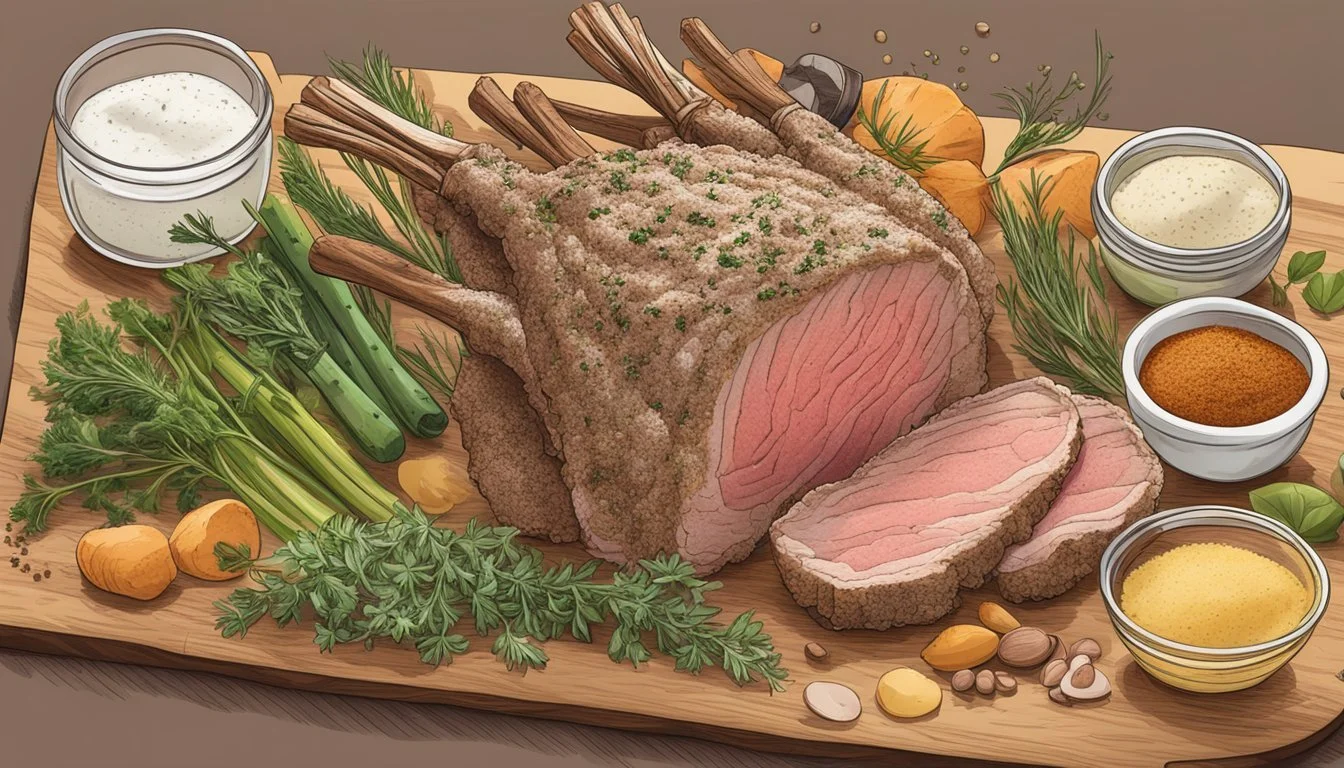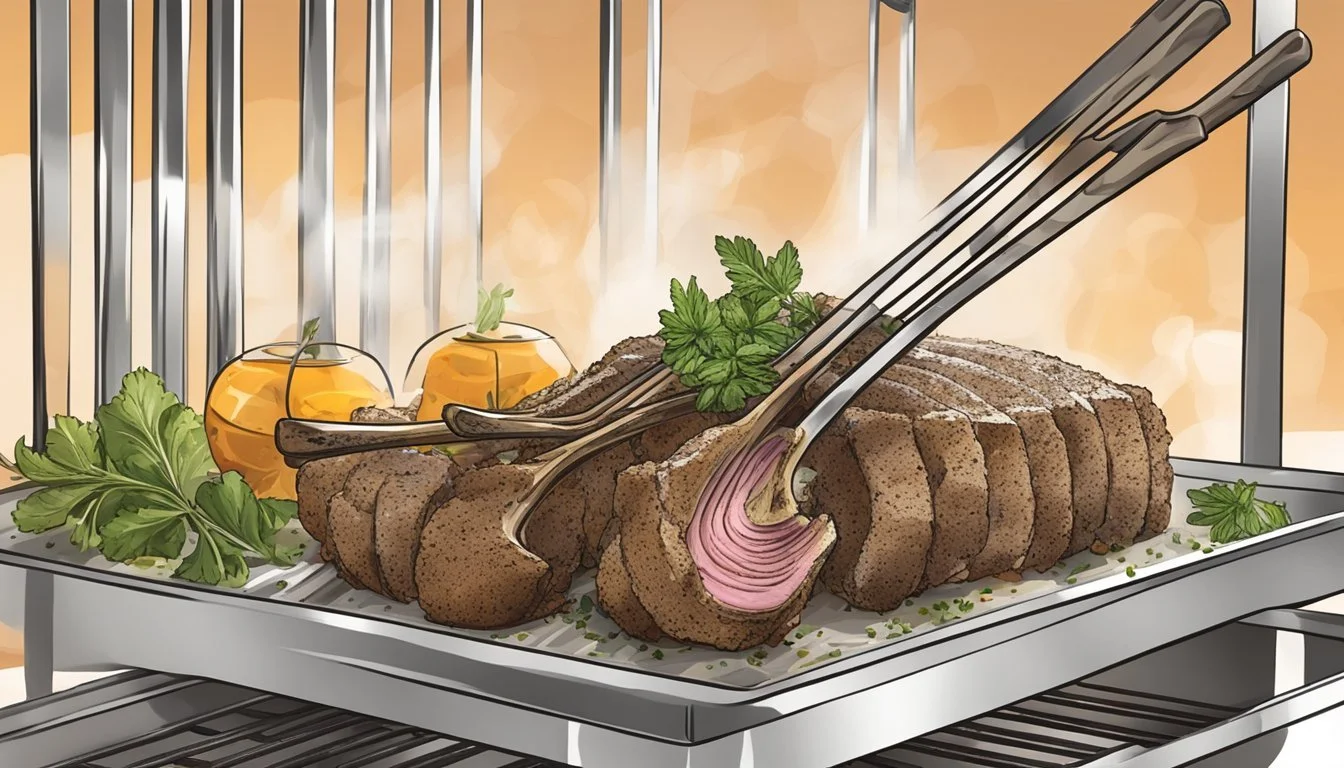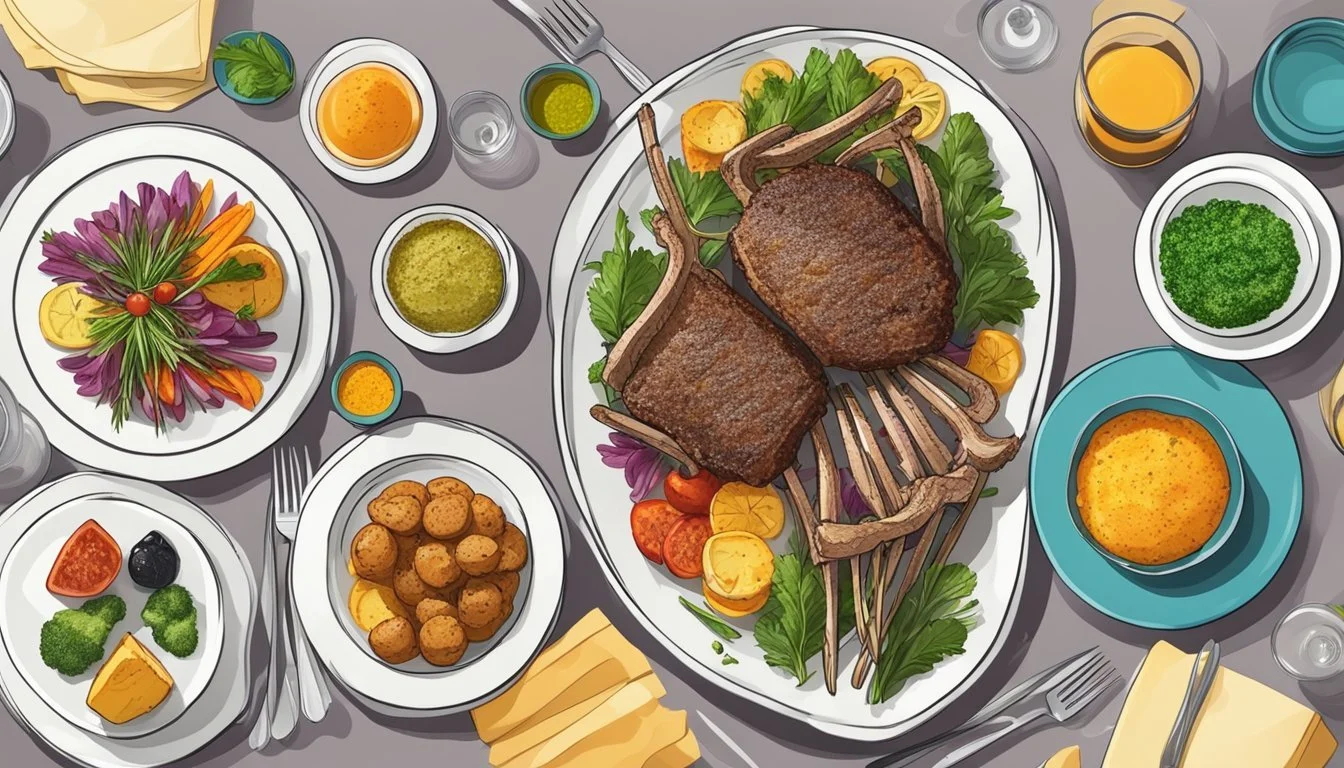Is Rack of Lamb Gluten-Free?
Understanding Meat and Gluten Concerns
Rack of lamb is a prime cut of meat that is popular for its tenderness and rich flavor. It is often prepared with a variety of herbs, spices, and coatings, which leads to questions about its gluten status. Gluten, a group of proteins found in wheat, barley, and rye, can cause health issues for individuals with celiac disease or gluten sensitivity. Whether a rack of lamb is gluten-free depends largely on the preparation method and the ingredients used in its cooking process.
In its pure form, the meat itself is naturally free of gluten. Problems can arise, however, when the lamb is crusted with ingredients that contain gluten, such as breadcrumbs or flour, or when it is marinated in sauces that have gluten-containing additives. It is crucial for those on a gluten-free diet to consider these factors when selecting or preparing a rack of lamb.
There are many variations of rack of lamb recipes that cater to a gluten-free diet. Some use gluten-free breadcrumbs or alternative flours for crusting, while others rely on a simple blend of herbs and seasonings without any gluten-containing ingredients. For those concerned about gluten, it is always important to verify the ingredients or ask the chef or manufacturer about the specific preparation methods used to ensure the dish is safely gluten-free.
Understanding Gluten
When considering if a rack of lamb is gluten-free, it's important to recognize what gluten is, understand the risks of cross-contamination, and know what gluten-free certification entails.
Defining Gluten-Free
Gluten refers to the proteins found in wheat, barley, rye, and triticale. A product is considered gluten-free if it does not contain these proteins or any derivative thereof. For individuals with celiac disease or gluten intolerance, consuming gluten-free foods is essential to avoid health complications. Products labeled as gluten-free must meet strict guidelines set by food safety authorities, ensuring that gluten levels do not exceed 20 parts per million.
Cross-Contamination Risks
Cross-contamination can occur during the processing, preparation, or cooking of food. Even if the lamb is naturally gluten-free, it can become contaminated if it comes into contact with gluten-containing ingredients. This contamination can happen:
On shared cooking surfaces
Through utensils that have been used with gluten-containing foods
Within manufacturing facilities that process both gluten-free and gluten-containing items
It's critical that individuals requiring a gluten-free diet be aware of these risks, especially when dining out or purchasing pre-prepared rack of lamb dishes.
Gluten-Free Certification
To further protect consumers, a gluten-free certification offers a credible guarantee that a product meets the required standards for being gluten-free. Third-party organizations provide these certifications after thorough testing and evaluation of the product and its manufacturing process. Below is a list of renowned organizations that certify gluten-free products:
The Gluten-Free Certification Organization (GFCO)
Celiac Support Association (CSA)
Beyond Celiac
Certification seals from these organizations are typically displayed on product packaging and indicate a higher level of trust and safety for gluten-free consumers.
Rack of Lamb Basics
In this section, we'll focus on the essential characteristics of a rack of lamb and its nutritional profile. Understanding these fundamentals will enable one to make informed decisions about incorporating rack of lamb into their diet.
Identifying Rack of Lamb
A rack of lamb is recognized by its distinctive row of ribs, tender meat, and a fat cap that adds flavor during cooking. It's generally prepared as a roasted dish, which enhances its natural richness. A typical rack of lamb includes 7 to 8 ribs, and can be identified by:
A trimmed backbone, also known as "Frenching"
Lean, red meat with a consistent layer of white fat
Freshness indicated by the color of the meat (bright red) and the absence of a strong odor
Nutritional Value of Lamb
When considering the nutritional aspects of lamb, it's essential to examine the compact nutrient profile it offers. Lamb is a high-quality protein source that provides essential amino acids required for bodily functions. The following table summarizes the key nutrition facts per 3-ounce serving of cooked, roasted lamb:
Nutrient Amount (3 oz serving) Calories Approx. 250 kcal Protein About 20g Fat Approx. 17g Saturated Fat Approx. 7g Cholesterol Around 75mg Vitamin B12 High concentration Iron Present
Lamb also contains other vitamins and minerals, such as niacin, zinc, and selenium. The precise amounts can vary depending on factors such as the cut of the meat and how it's cooked. It's important for individuals to consider these nutritional qualities when evaluating their dietary choices.
Ingredients Analysis
When preparing rack of lamb, it is essential to understand the ingredients used, both to maintain the rich flavors and to ascertain if the dish is gluten-free. This analysis will dissect common ingredients in lamb preparation and how to identify potential gluten-containing additives.
Common Ingredients for Lamb Preparation
The quintessence of a savory rack of lamb often hinges on a harmony of herbs and seasonings. A traditional preparation might include:
Garlic: Adds a pungent, spicy flavor that mellows with cooking.
Fresh Herbs: Often includes rosemary, thyme, and parsley, which impart aromatic depth.
Oils: Olive oil, particularly extra-virgin olive oil, is a standard choice for its ability to add flavor and facilitate cooking.
Seasonings: A simple yet effective blend of salt and black pepper is commonly employed.
Mustard: Dijon mustard serves both as an adherent for crusts and adds tangy complexity to the lamb.
Butter: Provides richness and helps to create a succulent finish.
Frenched Lamb: Refers to a preparation method where the rib bones are exposed, offering an elegant presentation.
Spotting Gluten in Ingredients
Gluten, a protein found in wheat, barley, rye, and crossbreeds of these grains, can lurk in various ingredients and side dishes, unbeknownst to many. To assure the gluten-free integrity of a rack of lamb, scrutinize the following:
Breadcrumbs: Often contain gluten, but gluten-free alternatives may use rice or corn-based options.
Sauces: Can harbor thickeners derived from gluten-containing grains. Opt for sauces labeled as gluten-free.
Store-Bought Marinades and Rubs: May include gluten as a binding agent or filler. Always check labels or prepare homemade versions using gluten-free elements.
In summary, lamb inherently is gluten-free, but attention must be given to the ingredients used in the preparation, especially if a gluten-free dish is the objective.
Preparation Techniques
When preparing a rack of lamb, it’s essential to use cooking methods and ingredients that maintain its gluten-free integrity while enhancing its natural flavors. Whether searing, roasting, or applying a herb crust, attention to detail ensures a delectable outcome.
Preparing Rack of Lamb
One begins by preheating a pan, preferably heavy-duty, to effectively sear the rack of lamb on all sides, achieving a savory brown crust while avoiding cooking the ends too much. The perfect sear sets the stage for further cooking, typically pursued by transferring the meat to a roasting pan.
Gluten-Free Cooking Methods
To ensure the meal remains gluten-free, the rack of lamb can be oven-roasted, which involves cooking it in a preheated oven at a temperature that typically ranges between 350°F to 375°F. For a medium-rare doneness, the internal temperature should reach 130 degrees F. For those preferring a grilled rack of lamb, it is essential to avoid cross-contamination with gluten-containing foods on the grill.
Herb-Crusting without Gluten
Creating a gluten-free herb crust involves substituting traditional breadcrumbs with gluten-free breadcrumbs or a blend of gluten-free herbs and spices. Combine fresh chopped herbs such as rosemary, parsley, or thyme with gluten-free breadcrumbs, salt, and pepper. Apply a thin layer of mustard to the lamb as a 'glue' before patting down the herb mixture firmly onto the meat to form a rich, flavorful crust.
Cooking Equipment
When preparing a rack of lamb, the right cooking equipment is crucial for both the cooking process and to maintain a gluten-free status. Cross-contact with gluten-containing foods can occur if equipment is shared, so utensils and cookware should be dedicated gluten-free when necessary.
Essential Kitchen Tools
For a gluten-free rack of lamb, one will need:
A roasting pan or a heavy, oven-proof pan, depending on the recipe specifics. The roasting pan is ideal for even cooking and is typically used when oven-roasting the lamb as a whole rack.
Tongs for safe handling and turning of the lamb while browning on the stove.
Bowls of varying sizes, preferably made from non-porous materials like glass or metal, which don’t harbor gluten remnants.
Measuring spoons and cups to accurately measure seasonings and oil.
Brushes or spoons to apply marinades or crusts that enhance flavor without adding gluten.
Foil or parchment paper may also be useful to line pans to prevent sticking and further reduce the risk of gluten cross-contamination.
Using a Thermometer for Perfect Doneness
A meat thermometer is an invaluable tool when cooking lamb. Here are the key reasons why:
Accuracy: It helps one ascertain the exact internal temperature of the lamb, reducing the guesswork and preventing undercooking or overcooking.
Safety: Ensuring the lamb reaches a safe minimum internal temperature is important for food safety. The USDA recommends an internal temperature of 145°F (63°C) followed by a 3-minute rest.
Consistency: With a thermometer, individuals can achieve their desired doneness every time, whether they prefer their lamb rare, medium-rare, or well-done.
By closely monitoring the temperature using a good-quality meat thermometer and following these equipment guidelines, one can create a delicious, gluten-free rack of lamb to perfection.
Serving Suggestions
When preparing rack of lamb for a dinner party or family meal, the selection of side dishes and sauces can transform this succulent dish into a memorable feast. The right accompaniments can complement the roast’s rich flavors and create a balanced plate.
Complementing Side Dishes
Side dishes should both contrast and harmonize with the main course. Here are well-suited options to serve alongside rack of lamb:
Vegetables: Roasted carrots or a medley of root vegetables offer a sweet, earthy counterpoint to the lamb's succulence.
Starches: Creamy mashed potatoes are a classic pairing, providing a smooth texture and neutral taste that enhances the meat's robust flavor.
Salads: A fresh salad, perhaps featuring crisp greens and Italian parsley, can add a bright, clean note to the meal.
Enhancing Flavor with Sauces
The right sauce not only complements the flavors of lamb but can also add an extra dimension to the dish:
Mint Sauce: Traditional and refreshing, mint sauce with a touch of lemon juice cuts through the richness of the meat.
Red Wine Reduction: This sauce can add a luxurious depth and complexity, which is particularly appealing for upscale dinner parties.
Storage and Leftovers
When it comes to maintaining the quality of rack of lamb leftovers, proper storage methods are crucial, as is the technique for reheating to ensure the dish remains enjoyable and as close to its original state as possible.
Proper Storage Methods
To extend the freshness and safety of leftover rack of lamb, one should store it within two hours of cooking. Leftovers must be placed in airtight containers and refrigerated at or below 40°F. It is recommended to consume the lamb within three to four days. For even longer storage, leftovers can be frozen—wrapped in freezer-safe materials—for up to three months. One should note that while rack of lamb generally comes in "racks," individuals may opt to separate these into servings or double chops before storage for easier future meal preparation.
Reheating Without Compromising Quality
To reheat rack of lamb leftovers while preserving their quality, one should avoid the microwave as it can unevenly heat and potentially toughen the meat. Instead, reheating in an oven preheated to 350°F is ideal. The lamb should be placed in an oven-safe dish and covered with foil to retain moisture. Reheating time may vary, but it is typically adequate once the internal temperature reaches 165°F, ensuring the meat is heated through but not overcooked. A thermometer can assist in monitoring this.
Accommodating Dietary Restrictions
When preparing rack of lamb for individuals with dietary restrictions, it is essential to consider appropriate substitutes and be mindful of other common allergens. The following information provides guidance on making this dish suitable for those who follow a gluten-free diet or have other allergies.
Gluten-Free Substitutes
To ensure that a rack of lamb is gluten-free, one must select ingredients, particularly marinades and crusts, that do not contain any gluten. Here are specific substitutions:
Breadcrumbs: Use gluten-free breadcrumbs or alternatives such as ground almonds or gluten-free panko to achieve the desired crust texture.
Sauces/Marinades: When using prepared sauces or marinades, verify that they are labeled gluten-free. Alternatively, mixtures made from scratch using gluten-free ingredients, like olive oil, herbs, garlic, and lemon juice, provide safe and flavorful options.
Managing Other Common Allergies
Aside from gluten, it's crucial to address other allergens when preparing a rack of lamb:
Dairy: If dairy is an issue, use dairy-free alternatives for any butter or cheese called for in the recipe. For instance, olive oil can be used in place of butter for basting.
Nuts: If substituting breadcrumbs with nut-based meals, ensure no nut allergies are present among the diners. Offer a nut-free alternative if necessary, like certified gluten-free oatmeal crust.
Adopting these strategies will enable you to serve a delicious rack of lamb to guests with these specific dietary needs without compromising on flavor or texture. It's always best to consult with guests regarding their dietary restrictions prior to preparing the meal.
Additional Tips from the Chef
Preparing a rack of lamb can be a rewarding culinary experience, and chefs often suggest paying close attention to details. They emphasize the importance of balancing flavors and properly cooking the lamb to achieve a gluten-free and delicious entrée.
Expert Cooking Tips
Servings: A standard serving of rack of lamb is typically two to four ribs per person. Chefs advise considering rest time for the lamb where the juices redistribute for more tender meat.
Fat: It’s crucial that the excess fat is trimmed, leaving just enough for flavor and moisture. The fat should be scored lightly; this helps the seasoning to penetrate and the fat to render properly.
Dry White Wine: A chef might deglaze the pan with dry white wine after searing the lamb. This not only intensifies the flavor but can also be used to create a sumptuous sauce to accompany the lamb. Ensure the wine is gluten-free if this is a dietary concern.
Black Pepper: Freshly ground black pepper is often preferred over pre-ground for its potent flavor. Chefs use it sparingly to compliment the lamb without overwhelming it.
Avoiding Common Pitfalls
Temperature: An instant-read thermometer can prevent overcooking—a common pitfall. Chefs ensure the internal temperature reaches 135°F (57°C) for medium-rare doneness.
Resting: Another key tip is allowing the lamb to rest for at least 10 minutes before carving; this prevents the juices from running out and drying the meat.
Cross-contamination: To keep the dish gluten-free, it's vital to avoid cross-contamination with gluten-containing items, especially when using shared kitchen appliances and utensils.
Seasoning: While seasonings enhance flavor, chefs use them judiciously to complement and not mask the natural taste of the lamb. They encourage checking seasoning blends for any hidden gluten.
Conclusion
Rack of lamb inherently is a gluten-free meat product, as it does not contain wheat, barley, rye, or their derivatives. However, thorough attention is necessary when preparing and serving this dish to ensure it maintains its gluten-free integrity.
Preparation: When incorporating additional ingredients such as herbs, spices, and coatings, one must verify that these are gluten-free. Common gluten-containing ingredients to avoid include certain bread crumbs and flours.
Cookware Caution: Cookware previously used for gluten-containing foods can pose a risk of cross-contamination. It's important to use clean utensils and cooking surfaces.
Serving Suggestions:
Mustard-Herb Crust: Use gluten-free bread crumbs mixed with herbs and mustard.
Pistachio Crust: A crust of crushed pistachios, gluten-free bread crumbs, and mustard can offer a delectable crust without the gluten.
Final Note: Individuals with celiac disease or gluten sensitivity should always ensure that every component of the meal, from seasonings to garnishes, is gluten-free. Chefs should not assume ingredients or prepared foods are gluten-free and should read labels or consult with manufacturers if there is any doubt.
By adhering to these guidelines, one can confidently serve a gluten-free rack of lamb that is both delicious and safe for individuals avoiding gluten in their diets.











